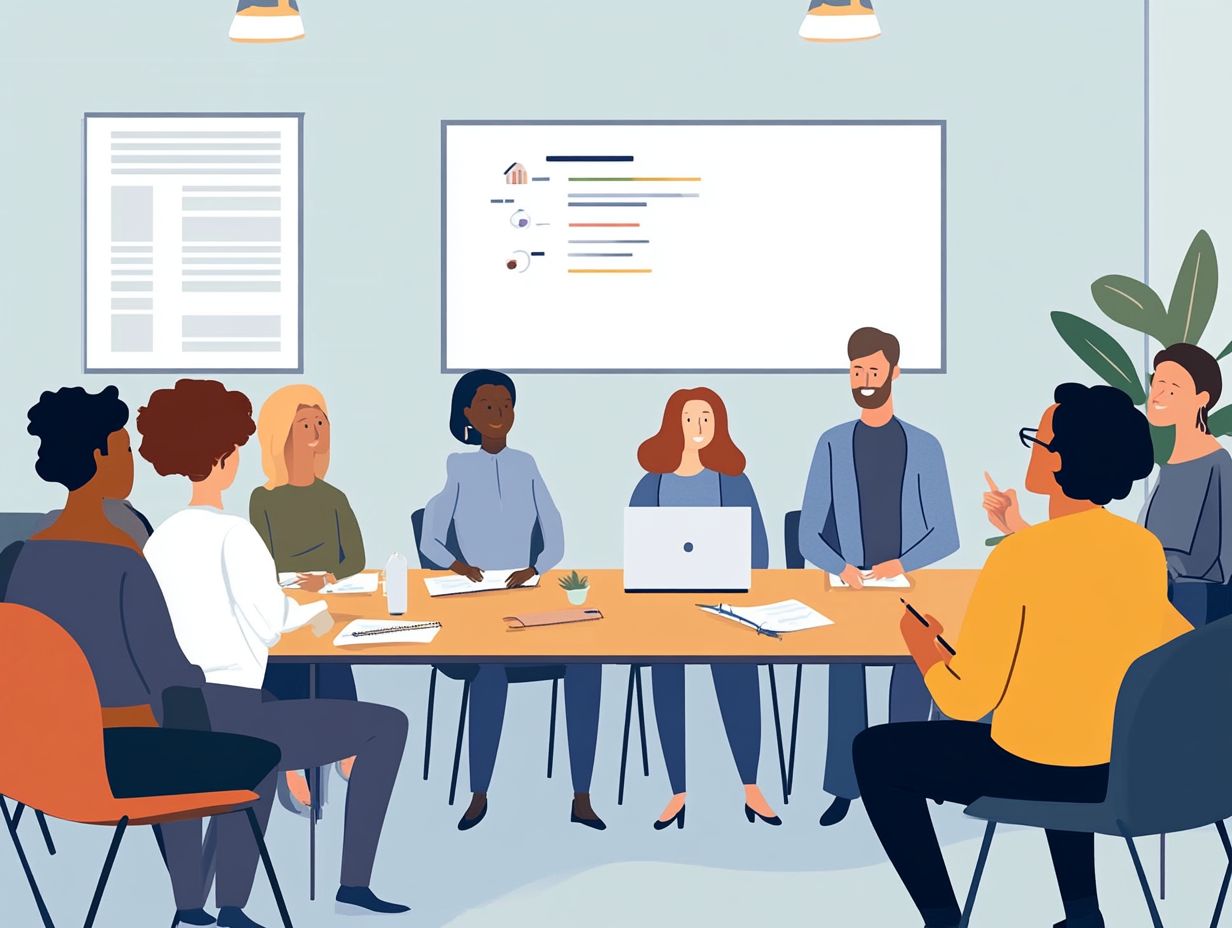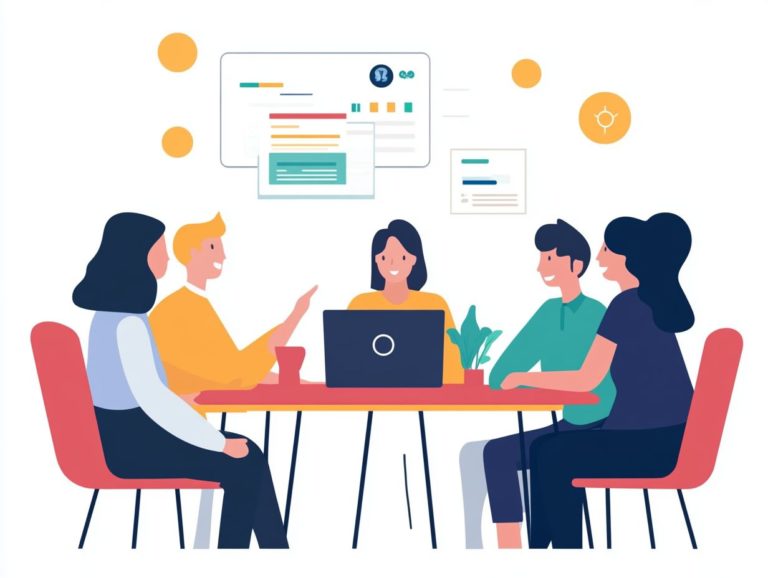“How to Adapt CRM Training for Different Users”
In today s fast-paced business landscape, mastering Customer Relationship Management (CRM) tools is absolutely essential for your success.
It’s important to recognize that not all users come to CRM with the same level of expertise or familiarity.
This article delves into the essentials of CRM training, guiding you on how to customize programs for different user groups, engage them with interactive methods, and evaluate the effectiveness of your training initiatives.
By grasping these key components, you can empower your team to enhance CRM effectiveness and foster stronger customer relationships.
Contents
- Key Takeaways:
- Understanding CRM Training
- Adapting CRM Training for Different Users
- Best Practices for Effective CRM Training
- Measuring the Success of CRM Training
- Key Metrics to Track
- Adjusting Training Based on Feedback
- Final Thoughts and Recommendations
- Frequently Asked Questions
- What is CRM training and why is it important?
- How do you identify the different user groups for CRM training?
- What are the key considerations when adapting CRM training for different user groups?
- How do you customize CRM training for different user groups?
- What are some tips for effectively adapting Customer Relationship Management (CRM) training for different user groups?
- How can you measure the success of CRM training for different user groups?
Key Takeaways:

Understand the importance of adapting CRM training for different user groups to ensure successful implementation.
Identify different user groups and customize training to cater to their specific needs and skill levels.
Utilize interactive and hands-on techniques, incorporate real-life scenarios, and track key metrics to measure the success of CRM training.
Understanding CRM Training
Understanding CRM training is crucial for organizations aiming to improve how they manage customer relationships. When you invest in effective training, you equip users with the skills and knowledge they need to harness CRM systems to their fullest potential.
This boosts customer interactions and satisfaction levels. Implement user training now to ease resistance and ensure data accuracy through proper utilization.
What is CRM Training?
CRM training is a structured educational journey crafted to arm you with the knowledge and skills essential for harnessing the full power of customer relationship management systems. This training typically covers a range of topics, from basic navigation to advanced analytical techniques, ensuring you can truly maximize the system’s potential.
The primary goals of CRM training are to enhance your proficiency, elevate productivity, and refine your customer engagement strategies. Effective training is vital, as it bridges the knowledge gaps that often inhibit the optimal use of these remarkable tools.
Consider hands-on workshops and e-learning modules that promote experiential learning. Collaborative group sessions encourage valuable knowledge sharing. By embracing a variety of training methods, organizations can significantly enhance your understanding, streamline workflows, and ultimately elevate customer satisfaction.
Adapting CRM Training for Different Users
Adapting CRM training for various users is essential to maximize the effectiveness of your customer relationship management initiatives.
By tailoring training strategies to suit different user roles, you ensure that everyone can fully benefit from the program. This approach not only enhances overall engagement but also fosters a more cohesive understanding of CRM tools across your organization.
Identifying Different User Groups
Identifying the various user groups within your organization is the foundational step to crafting an impactful CRM training program that caters to the unique needs of each role.
To accomplish this, you should categorize users based on their specific responsibilities, such as:
- Sales representatives who concentrate on attracting and closing deals.
- Marketing teams dedicated to lead generation and brand promotion.
- Customer service agents who maintain client relationships and address inquiries.
Grasping these roles is essential, as it informs the selection of the right business tools tailored to each group’s objectives. For example, sales representatives could greatly benefit from tools that enhance their pipeline tracking, while marketing teams may need analytics platforms to effectively gauge campaign performance.
By developing targeted training strategies, you can elevate each user group’s proficiency with the tools they will employ, paving the way for a more cohesive and efficient organization.
Start tailoring your CRM training today to empower your team and strengthen customer relationships!
Customizing Training for Each User Group

Customizing training for each user group is vital. It keeps your CRM training relevant and engaging, leading to a better experience for users.
Your sales teams may need modules that focus on quick, actionable insights. In contrast, customer service representatives could benefit from in-depth case studies and role-playing exercises. By acknowledging the distinct responsibilities across departments, you can create tailored content that aligns with their tasks.
As users progress, it’s essential to keep engagement alive. Actively solicit feedback and update the training materials to reflect any changes in their roles or learning preferences. This approach ensures your program remains dynamic and effective over time.
Best Practices for Effective CRM Training
Implementing best practices for effective CRM training is essential for achieving CRM adoption. This ensures that you can leverage CRM systems to enhance your business processes with unparalleled efficiency.
Creating a Comprehensive Training Plan
Creating a comprehensive training plan requires outlining clear objectives, resources, and timelines. This ensures your CRM training aligns seamlessly with your overall implementation goals.
Identify specific training objectives tailored to your organization s unique needs. This cultivates an environment that truly fosters learning.
It’s essential to allocate resources carefully. Include expert trainers, technology tools, and engaging learning materials to enhance the training experience.
A well-structured schedule is crucial. It allows participants to immerse themselves in the content without disrupting their daily responsibilities.
When these components are thoughtfully combined, they streamline the CRM adoption process. This facilitates a smooth transition, enabling users to confidently embrace the new system from day one.
Utilizing Interactive and Hands-On Techniques
Interactive, hands-on techniques in CRM training will boost user engagement and retention of CRM features and functionalities.
Incorporating simulations that replicate real-life scenarios makes it easier to navigate the complex functionalities of the CRM system. Role-playing exercises help you step into various roles, enhancing your understanding of different perspectives within the platform.
Real-time collaboration exercises promote teamwork and problem-solving. These immersive activities deepen your knowledge and instill confidence, enabling you to leverage the CRM system effectively in your daily tasks.
Incorporating Real-Life Scenarios
Incorporating real-life scenarios into your CRM training is key to applying your knowledge to actual customer interactions. This makes the training not just relevant but truly impactful.
Design sessions that capture the complexities of real-world situations. This better prepares you for the challenges you might face, encouraging active engagement and critical thinking as you navigate various customer journey stages and touchpoints.
Including role-playing exercises and case studies allows you to explore different perspectives. This fosters empathy and enhances your decision-making skills. The real-time feedback you receive during these simulations helps refine your techniques, leading to more effective communication and relationship-building with clients an essential part of successfully implementing CRM strategies.
Measuring the Success of CRM Training

Measuring the success of your CRM training is crucial. It helps you evaluate user proficiency and training effectiveness in your organization.
This assessment highlights areas for improvement and reinforces the value of well-executed training programs in enhancing operational efficiency.
Key Metrics to Track
When measuring the success of your customer relationship management (CRM) training, it is essential to track key metrics such as user proficiency levels, CRM adoption rates, and the overall enhancement of business operations.
Examining these metrics provides clearer insight into how effectively your training initiatives resonate with users. Monitoring user proficiency levels shows how quickly individuals adapt to the system and helps identify areas where they might need additional support.
Keeping an eye on CRM adoption rates is crucial; a significant increase indicates that employees find genuine value in the training provided.
Evaluating the connection between your training efforts and improved business outcomes like enhanced customer interactions and streamlined processes validates the program’s impact on overall efficiency and user engagement.
Adjusting Training Based on Feedback
Adjusting your training based on feedback is essential for continuous improvement in training effectiveness and user experience. Creating effective feedback loops is vital for refining programs.
By actively engaging participants throughout the training sessions, you can gather valuable insights into what resonates with learners and what falls flat. This may involve quick surveys, informal discussions, or interactive tools that facilitate real-time feedback.
These mechanisms not only give participants a voice but also enable you to make informed adjustments to your training content and methodologies. This leads to a more tailored experience that aligns with the audience’s needs and preferences, fostering a sense of ownership and commitment among participants.
Final Thoughts and Recommendations
Effective CRM training should be viewed as an ongoing journey that evolves to meet your needs and the shifting landscape of your organization. This approach standardizes practices across teams and cultivates a culture of continuous learning, enabling you to navigate new technologies and market dynamics with confidence.
By actively seeking feedback and regularly updating your training materials, you can refine your CRM strategies, enhancing customer interactions and satisfaction.
Ultimately, the goal is to develop a resilient workforce that can adeptly respond to the ever-changing world of customer relationship management, driving success and productivity throughout the organization. Embrace the journey of CRM training it’s your key to staying ahead in a fast-changing world!
Frequently Asked Questions
Here are some common questions about CRM training that can help clarify its importance.
What is CRM training and why is it important?

CRM training refers to the process of educating users on how to effectively use customer relationship management (CRM) software. It is important because it helps users understand the features and functionalities of the CRM system, allowing them to maximize productivity.
How do you identify the different user groups for CRM training?
The first step in adapting CRM training for different users is identifying user groups by analyzing the roles and responsibilities of each individual within the organization and their specific needs and goals when using the CRM software.
What are the key considerations when adapting CRM training for different user groups?
When adapting CRM training for different user groups, consider factors such as the users’ level of technical proficiency, their individual learning styles, and their specific job roles and responsibilities. This helps tailor the training to meet each group’s needs.
How do you customize CRM training for different user groups?
Customizing CRM training involves creating distinct training materials and delivery methods that cater to the specific needs and goals of each group. This may include using different training modules, incorporating hands-on exercises, and providing one-on-one support for certain user groups.
What are some tips for effectively adapting Customer Relationship Management (CRM) training for different user groups?
Involve representatives from each user group in the training planning process. Their input will ensure that everyone s needs are met.
Use a mix of training methods, such as online tutorials and in-person workshops. Incorporate interactive exercises to enhance learning.
Offer continuous support that keeps users excited about learning! Provide resources that reinforce what they ve learned.
Regularly gather feedback from users. This helps improve the training program over time.
How can you measure the success of CRM training for different user groups?
Measure the success of CRM training by tracking user adoption rates, productivity, and satisfaction. Look at these metrics to see how well users are adapting.
Conduct surveys and collect feedback from users. This will give you valuable insights into the training program’s effectiveness.






